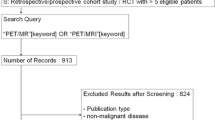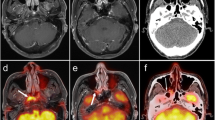Abstract
Purpose
The aim of this study was to evaluate the diagnostic capability of simultaneous 18F-fluorodeoxyglucose (FDG) positron emission tomography (PET)/MRI compared to 18F-FDG PET/CT as well as their single components in head and neck cancer patients.
Methods
In a prospective study 17 patients underwent 18F-FDG PET/CT for staging or follow-up and an additional 18F-FDG PET/MRI scan with whole-body imaging and dedicated examination of the neck. MRI, CT and PET images as well as PET/MRI and PET/CT examinations were evaluated independently and in a blinded fashion by two reader groups. Results were compared with the reference standard (final diagnosis determined in consensus using all available data including histology and follow-up). Sensitivity, specificity, positive predictive value (PPV) and negative predictive value (NPV) were calculated.
Results
A total of 23 malignant tumours were found with the reference standard. PET/CT showed a sensitivity of 82.7 %, a specificity of 87.3 %, a PPV of 73.2 % and a NPV of 92.4 %. Corresponding values for PET/MRI were 80.5, 88.2, 75.6 and 92.5 %. No statistically significant difference in diagnostic capability could be found between PET/CT and PET/MRI. Evaluation of the PET part from PET/CT revealed highest sensitivity of 95.7 %, and MRI showed best specificity of 96.4 %. There was a high inter-rater agreement in all modalities (Cohen’s kappa 0.61–0.82).
Conclusion
PET/MRI of patients with head and neck cancer yielded good diagnostic capability, similar to PET/CT. Further studies on larger cohorts to prove these first results seem justified.




Similar content being viewed by others
References
Wippold FJ. Head and neck imaging: the role of CT and MRI. J Magn Reson Imaging 2007;25:453–65.
de Bondt RBJ, Nelemans PJ, Bakers F, Casselman JW, Peutz-Kootstra C, Kremer B, et al. Morphological MRI criteria improve the detection of lymph node metastases in head and neck squamous cell carcinoma: multivariate logistic regression analysis of MRI features of cervical lymph nodes. Eur Radiol 2009;19:626–33.
Castelijns JA, van den Brekel MWM. Imaging of lymphadenopathy in the neck. Eur Radiol 2002;12:727–38.
Nakamura T, Sumi M. Nodal imaging in the neck: recent advances in US, CT and MR imaging of metastatic nodes. Eur Radiol 2007;17:1235–41.
Yoon DY, Hwang HS, Chang SK, Rho YS, Ahn HY, Kim JH, et al. CT, MR, US,18F-FDG PET/CT, and their combined use for the assessment of cervical lymph node metastases in squamous cell carcinoma of the head and neck. Eur Radiol 2009;19:634–42.
Ghanooni R, Delpierre I, Magremanne M, Vervaet C, Dumarey N, Remmelink M, et al. 18F-FDG PET/CT and MRI in the follow-up of head and neck squamous cell carcinoma. Contrast Media Mol Imaging 2011;6:260–6.
Beyer T, Freudenberg LS, Czernin J, Townsend DW. The future of hybrid imaging-part 3: PET/MR, small-animal imaging and beyond. Insights Imaging 2011;2:235–46.
Antoch G, Bockisch A. Combined PET/MRI: a new dimension in whole-body oncology imaging? Eur J Nucl Med Mol Imaging 2009;36 Suppl 1:S113–20.
Klinke T, Daboul A, Maron J, Gredes T, Puls R, Jaghsi A, et al. Artifacts in magnetic resonance imaging and computed tomography caused by dental materials. PLoS One 2012;7:e31766.
Castelijns JA. PET-MRI in the head and neck area: challenges and new directions. Eur Radiol 2011;21:2425–6.
Boss A, Stegger L, Bisdas S, Kolb A, Schwenzer N, Pfister M, et al. Feasibility of simultaneous PET/MR imaging in the head and upper neck area. Eur Radiol 2011;21:1439–46.
Platzek I, Beuthien-Baumann B, Schneider M, Gudziol V, Langner J, Schramm G, et al. PET/MRI in head and neck cancer: initial experience. Eur J Nucl Med Mol Imaging 2013;40:6–11.
Pearce T, Philip S, Brown J, Koh DM, Burn PR. Bone metastases from prostate, breast and multiple myeloma: differences in lesion conspicuity at short-tau inversion recovery and diffusion-weighted MRI. Br J Radiol 2012;85:1102–6.
Sommer G, Klarhöfer M, Lenz C, Scheffler K, Bongartz G, Winter L. Signal characteristics of focal bone marrow lesions in patients with multiple myeloma using whole body T1w-TSE, T2w-STIR and diffusion-weighted imaging with background suppression. Eur Radiol 2011;21:857–62.
Heusner T, Kuemmel S, Koeninger A, Hamami ME, Hahn S, Quinsten A, et al. Diagnostic value of diffusion-weighted magnetic resonance imaging (DWI) compared to FDG PET/CT for whole-body breast cancer staging. Eur J Nucl Med Mol Imaging 2010;37:1077–86.
Nakamoto Y, Tamai K, Saga T, Higashi T, Hara T, Suga T, et al. Clinical value of image fusion from MR and PET in patients with head and neck cancer. Mol Imaging Biol 2009;11:46–53.
Huang S, Chien C, Lin W, Fang FM, Wang PW, Lui CC, et al. A comparative study of fused FDG PET/MRI, PET/CT, MRI, and CT imaging for assessing surrounding tissue invasion of advanced buccal squamous cell carcinoma. Clin Nucl Med 2011;36:518–25.
Boellaard R, Krak NC, Hoekstra OS, Lammertsma AA. Effects of noise, image resolution, and ROI definition on the accuracy of standard uptake values: a simulation study. J Nucl Med 2004;45:1519–27.
Guenzel T, Franzen A, Wiegand S, Kraetschmer S, Jahn JL, Mironczuk R, et al. The value of PET compared to MRI in malignant head and neck tumors. Anticancer Res 2013;33:1141–6.
Acknowledgments
The simultaneous PET/MRI device (Siemens Biograph mMR, Siemens Healthcare, Erlangen, Germany) was promoted and funded by the Deutsche Forschungsgemeinschaft (German Research Foundation), Bonn, Germany.
Conflicts of interest
None.
Author information
Authors and Affiliations
Corresponding author
Additional information
K. Kubiessa and S. Purz contributed equally to this work.
Rights and permissions
About this article
Cite this article
Kubiessa, K., Purz, S., Gawlitza, M. et al. Initial clinical results of simultaneous 18F-FDG PET/MRI in comparison to 18F-FDG PET/CT in patients with head and neck cancer. Eur J Nucl Med Mol Imaging 41, 639–648 (2014). https://doi.org/10.1007/s00259-013-2633-2
Received:
Accepted:
Published:
Issue Date:
DOI: https://doi.org/10.1007/s00259-013-2633-2




